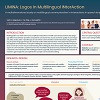Multilingual communication in Speech Language Therapy
DOI:
https://doi.org/10.51751/dujal15520Keywords:
Multilingual communication, Inclusive healthcare, Speech Language Therapy, Discours analysisAbstract
Multilingualism can both enrich and complicate interactions in health care. Several studies (Ferguson, 2002; Jacobs, 2017) point out that language differences between care providers and patients can lead to less access to and lower quality of care. More specifically, challenges regarding communication, mutual understanding and shared decision making are often present (Cox & Maryns, 2021; Schouten et al., 2017) in health care situations.
A specific type of care where communication is both instrument and goal of therapy is Speech language therapy (SLT). This profession offers guidance for people who experience difficulties with communication. In the daily practice of speech language therapists (SLTs) clients are vulnerable in their communication in different ways (Blackstone, 2015). For example, in multiethnic cities in the Netherlands many people have limited language proficiency in Dutch and they can also have a communication disorder These converging communication vulnerabilities form a challenge for SLTs. Several studies within the field of SLT have been performed to improve the diagnosis and treatment of complex multilingual cases (Hyter & Salas-Provance, 2023), but little research has been done on the actual interaction during those multilingual encounters (Hand, 2006). Although SLTs are experts in communication, experiences from the work field indicate that these professionals often feel less competent when interacting with multilingual clients or their parents (Lagendijk, 2021). As these situations occur very often in SLT practice and are quite complex due to interfering communication vulnerabilities, they need to be critically explored.
The current PhD study LIMINA (Logos In Multilingual InterAction) aims to gain insight into multilingual communication in Speech language therapy in order to enhance inclusive care. By carrying out various research methods (discourse analysis, in depth interviews, focus groups and design based research) different perspectives in the SLT setting are being explored. Data from the actual interaction will be compared and synthesized with the perspectives of clients and professionals in order to create a kaleidoscopic view. Moreover, the project intends to design a practical intervention in co-creation with representatives from the work field in order to enhance inclusive communication in SLT care.
For the purpose of the first sub study, students of the Rotterdam University of Applied Sciences collected transcripts from conversations between SLTs and parents, representing their underaged children. Two datasets were composed for the current analysis: a) transcripts of intake sessions (n = 15) and b) transcripts of test results discussions (n = 18). Parents have diverse linguistic backgrounds and most of the conversations took place in Dutch, without an interpreter.
By performing a critical discourse analysis (Ten Thije, 2001) multilingual interactions are currently being reconstructed in order to gain insight in patterns, structures and (un)successful actions. Preliminary results show that both SLTs and parents use several interactional strategies for inclusive multilingualism (Backus, 2013) during consults. Mostly supporting materials, such as reports, were used by the SLT to facilitate the verbal interaction; especially during the test result discussions. Also gesturing, writing and drawing were often used as strategies to facilitate the conversation. In five (out of fifteen) intake sessions no strategies were used during interaction. These parents were considered to be sufficiently fluent in the Dutch language by the researchers who analyzed the transcripts. In none of the test result discussions (n = 18) an interpreter was present to enhance understanding.
First conclusions regarding inclusive multilingualism in SLT care reveal that although participants choose different ways to support their verbal message, this does not guarantee an adequate transfer of knowledge within the institutional setting of Speech language therapy. Specific conversational goals from both SLTs and parents were often not achieved during the intake sessions and test results discussions. This seems to correspond with the earlier reported experiences of SLTs (Lagendijk, 2021) and underlines the importance of the current study.
The present poster gives a textual and graphical overview of the research design for the overarching PhD study LIMINA. The indicated colors represent the different sub studies and the image shows an authentic fragment of a resolved misunderstanding between a parent and a speech language therapist. Furthermore, the poster provides a table of preliminary results concerning the interactional strategies used by SLTs and parents during institutional encounters.
Downloads
References
Backus, A., Gorter, D., Knapp, K., Schjerve-Rindler, R., Swanenberg, J., ten Thije, J.D. & Vetter, E. (2013). Inclusive multilingualism: Concept, Modes and Implications. Journal of Applied Linguistics (EuJAL), 1 (2), 179-215. https://doi.org/10.1515/eujal-2013-0010.
Blackstone, S.W. Beukelman,, D.R. & Yorkston, K.M. (Eds.) (2015). Patient- provider communication: Roles for speech-language pathologists and other health care professionals. Plural Publishing Inc.
Cox, A., Maryns, K. (2021). Multilingual consultations in urgent medical care. The translator, 1-19. https://doi.org/10.1080/13556509.2020.1857501
Ferguson, W.J. (2002). Culture, language, and the doctor-patient relationship. Family Medicine and Community Health Publications and Presentations, 34 (5), 353-361.
Hand, L. (2006). Clinicians as ‘Information Givers’: What Communication Actions Are Clients Given to Speech Language Pathology Services? Topics in Language Disorders, vol. 26, 3, 240-265.
Hyter, Y.D., Salas-Provance, M.B. (2023). Culturally Reponsive Practices in Speech, Language, and Hearing Science (second edition). Plural Publishing.
Jacobs, E.A. & Diamond, L.C. (2017). Providing health care in the context of language barriers: International perspectives. Multilingual Matters.
Lagendijk, S. (2021). Ouderbetrokkenheid in de logopediepraktijk, meertalige ouders die het Nederlands beperkt beheersen betrekken bij de logopedische behandeling (Bachelor thesis), Logopedie, Hogeschool Rotterdam.
Schouten, B.C., Cox, A., Duran, G., Kerremans, K., Köseoğlu Banning, L., Lahdidioui, A., van den Muijsenbergh, M., Schinkel, S., Sungur, H., Suurmond, J., Zendedel, R. & Krystallidou, D. (2020). Mitigating language and cultural barriers in healthcare communication: Toward a holistic approach, Patient Education and Counseling, 103, 2604-2608.
https://doi.org/10.1016/j.pec.2020.05.001.
Ten Thije, J. (2001). Stufen des Verstehens bei der Interpretation von Interkulturellen Diskursen. In H. Kothoff (Red.), Kultur(en) im Gespräch. (pp. 57-93). Narr

Downloads
Published
Issue
Section
License
Copyright (c) 2023 Sione Twilt, Karin Neijenhuis, Jan ten Thije, Rick de Graaff

This work is licensed under a Creative Commons Attribution 4.0 International License.
